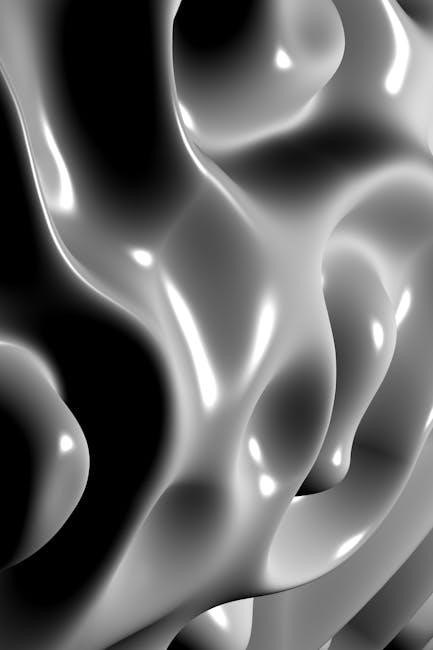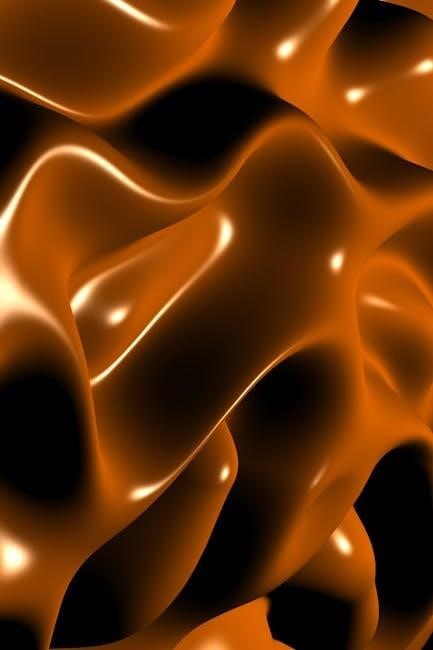Plasma cutter troubleshooting involves identifying and resolving issues to ensure optimal cutting performance. Common problems include poor cut quality, torch malfunction, and electrical issues. Regular maintenance and safety precautions are essential to prevent equipment damage and ensure operator safety. Understanding these fundamentals is key to effective troubleshooting and extending the lifespan of your plasma cutter.
1.1 Understanding Common Plasma Cutter Issues
Identifying common issues with plasma cutters is crucial for effective troubleshooting. Problems often stem from worn consumables, incorrect air pressure, or improper torch assembly. Issues like poor cut quality, torch malfunction, and electrical faults can arise from factors such as low air pressure, high amperage, or contaminated parts. Understanding these root causes helps operators address them promptly, preventing equipment damage and ensuring safety. Regular inspection of nozzles, electrodes, and gas flow is essential to maintain optimal performance. By recognizing these common problems, users can implement preventive measures and resolve issues efficiently, ensuring smooth operation and extending the lifespan of the plasma cutter.
1.2 Importance of Regular Maintenance
Regular maintenance is vital to ensure the optimal performance and longevity of a plasma cutter. Over time, consumable parts such as nozzles and electrodes wear out, leading to poor cut quality and reduced efficiency. Cleaning the cutting tip and checking for air leaks can prevent issues like uneven cuts or misfires. Properly storing consumables and ensuring correct assembly of the torch are also critical. Neglecting maintenance can result in premature wear, electrical faults, and safety hazards. A well-maintained plasma cutter not only delivers better results but also reduces downtime and extends the lifespan of the equipment, making it a cost-effective practice for consistent operation.
1.3 Safety Precautions for Troubleshooting
When troubleshooting a plasma cutter, prioritize safety to avoid accidents. Always disconnect the power supply before inspecting or repairing the equipment. Wear protective gear, including heat-resistant gloves, safety goggles, and a face shield, to guard against electrical arcs, sparks, and hot components. Ensure proper ventilation to prevent inhaling fumes from cutting operations. Never touch electrical components with bare hands, as high voltage can cause severe injury. Keep flammable materials away from the workspace. Follow the manufacturer’s guidelines for safe operation and maintenance. By adhering to these precautions, you minimize risks and create a safer environment for effective troubleshooting and equipment repair.

Common Plasma Cutter Problems
Poor cut quality, torch malfunction, electrical issues, premature consumable wear, contamination, incorrect parts installation, and dragging the torch are frequent challenges faced during plasma cutting operations.
2.1 Poor Cut Quality
Poor cut quality is a common issue in plasma cutting, often resulting in uneven, jagged, or beveled edges. This problem can stem from incorrect torch height, improper air pressure, or a worn-out cutting nozzle. Additionally, insufficient or excessive gas flow, along with incorrect amperage settings, can degrade cut quality. Dirty or contaminated consumables, such as the cutting tip or electrode, may also contribute to poor performance. Regular maintenance, including cleaning and replacing worn parts, is essential to achieving clean, precise cuts. Proper alignment and ensuring consistent cutting speed can further enhance results. Addressing these factors helps maintain optimal performance and extends the life of your plasma cutter.
2.2 Torch Malfunction
Torch malfunction is a frequent issue in plasma cutters, often causing inconsistent or failed ignition. This problem can arise from a faulty pilot arc, worn-out consumables, or improper assembly of the torch components. Incorrect installation of the nozzle or electrode can disrupt the plasma arc, leading to poor performance. Additionally, contamination from debris or moisture in the torch can interfere with its operation. Regular inspection and cleaning of the torch, along with replacing damaged or worn parts, are crucial to preventing malfunctions. Properly grounding the equipment and ensuring all connections are secure can also help maintain reliable torch function. Addressing these issues promptly ensures smooth operation and extends the torch’s lifespan.
2.3 Electrical Issues
Electrical issues are common in plasma cutters and can significantly disrupt operation. Problems such as low input AC voltage, faulty connections, or tripped circuit breakers can prevent the machine from functioning properly. A malfunctioning power supply or incorrect voltage settings may also cause erratic behavior. Additionally, loose or corroded electrical connections can interfere with the plasma cutter’s performance. To troubleshoot, ensure the power supply meets the recommended voltage and check all connections for tightness and cleanliness. Using a dedicated circuit can also help stabilize power delivery. Addressing these electrical issues promptly is essential to maintain consistent cutting performance and prevent further damage to the equipment.
2.4 Premature Consumable Wear
Premature wear of plasma cutter consumables, such as nozzles and electrodes, is a common issue that can increase maintenance costs. This problem often arises due to improper installation, incorrect amperage settings, or insufficient cooling. Contaminated air flow, high torch standoff, and excessive cutting speed can also accelerate wear. Regular inspection and replacement of worn parts are crucial to prevent damage. Using high-quality consumables and following manufacturer guidelines can help extend their lifespan. Additionally, ensuring proper alignment during assembly and maintaining consistent operating parameters can minimize premature wear, optimizing the performance and longevity of your plasma cutter. Addressing these factors ensures reliable operation and reduces downtime.
2.5 Contamination and Wear
Contamination and wear are significant factors affecting plasma cutter performance. Dirt, oil, or moisture in the air supply can damage consumables and degrade cut quality. Improper storage of consumables or exposure to harsh environments can also lead to premature wear. Regular inspection of nozzles and electrodes for signs of contamination or abrasion is essential. Cleaning the cutting tip and ensuring dry, compressed air flow can prevent issues. Additionally, avoiding contact between the torch and workpiece reduces wear. Proper handling and storage of consumables in a clean, dry environment minimize contamination risks. Addressing these factors ensures consistent performance and extends the lifespan of plasma cutter components, reducing operational downtime and maintenance costs.
2.6 Incorrect Parts Installation
Incorrect installation of plasma cutter parts can lead to poor performance and safety risks. Using mismatched or incompatible consumables, such as nozzles or electrodes, can result in inconsistent cuts or equipment malfunction. Improper assembly of the torch or incorrect alignment of components can disrupt the plasma arc, causing uneven cuts or premature wear. Additionally, failure to follow the manufacturer’s installation guidelines may void warranties or compromise safety. Always ensure that parts are compatible with your plasma cutter model and installed according to the manufacturer’s instructions. Regularly inspect installed components for proper fitment and alignment to maintain optimal performance and prevent operational issues.
2.7 Dragging the Torch
Dragging the torch during plasma cutting can lead to uneven cuts, increased wear on consumables, and reduced cut quality. This issue often occurs when the torch is not held at the correct height or angle, causing it to make contact with the workpiece. Proper torch height and angle are critical to maintaining a stable plasma arc. Using a drag cutting technique without the appropriate nozzle or settings can exacerbate the problem. Always ensure the torch is guided smoothly and consistently, avoiding direct contact with the material. Regularly inspect the nozzle for wear, as dragging can damage it and affect performance. Correcting this issue requires adjusting the torch height, maintaining proper technique, and using the right consumables for drag cutting applications.

Troubleshooting Steps
Troubleshooting a plasma cutter involves systematic checks: verify air pressure, inspect consumables, reboot the system, and ensure proper grounding. These steps help identify and resolve issues efficiently.
3.1 Checking Air Pressure
Checking air pressure is a critical step in plasma cutter troubleshooting. Proper pressure ensures consistent cutting performance and prevents misfires. Low pressure can lead to incomplete cuts, while excessively high pressure may damage the torch or nozzle. Always refer to the manufacturer’s guidelines for the recommended pressure range. Use a pressure gauge to verify settings and check for air leaks in hoses and connections. Adjust the compressor or regulator as needed to maintain optimal pressure. This simple step can resolve many common issues and improve overall cutting efficiency. Regular checks help maintain equipment reliability and extend the life of consumable parts.
3.2 Verifying Power Settings
Verifying power settings is essential for ensuring your plasma cutter operates efficiently. Incorrect power settings can lead to poor cut quality, uneven edges, or even equipment damage. Always check that the input voltage matches the manufacturer’s specifications, as fluctuations can affect performance. Use a multimeter to measure the output voltage and current, ensuring they align with recommended levels for your specific plasma cutter model. Additionally, verify that the amperage settings are appropriate for the thickness and type of material being cut. Proper power calibration prevents overheating, extends consumable life, and enhances cutting accuracy. Regularly reviewing and adjusting these settings helps maintain consistent results and prevents potential operational issues;
3.3 Inspecting Consumable Parts
Inspecting consumable parts is crucial for maintaining plasma cutter performance. Regularly examine the nozzle, electrode, and other wear components for signs of damage or erosion. A worn or dirty nozzle can cause poor cut quality, while a damaged electrode may prevent the arc from initiating properly. Clean the cutting tip to remove any debris or spatter that could obstruct gas flow. Replace consumables as soon as you notice significant wear, as this prevents further damage to the torch or system. Proper inspection and maintenance of these parts ensure consistent cutting results, reduce downtime, and extend the lifespan of your plasma cutter. Always refer to the manufacturer’s guidelines for replacement intervals and specifications.

3.4 Rebooting the Plasma System
Rebooting the plasma system can often resolve operational issues such as erratic arc behavior or system malfunctions. Start by turning off the plasma cutter and disconnecting it from the power source. Allow the system to cool down for a few minutes to ensure all components are idle. Next, reconnect the power and turn the system back on, following the manufacturer’s startup procedure. This process resets the internal electronics and clears any temporary glitches. Additionally, check that all connections, including the ground cable, are secure before restarting. Rebooting can address software-related issues, power surges, or communication errors between components, ensuring smoother operation and consistent cutting performance. Regular system resets can prevent recurring problems and maintain reliability.
3.5 Properly Grounding the Equipment

Properly grounding the plasma cutter is crucial for safe and effective operation. A poor or faulty ground connection can lead to inconsistent cuts, electrical hazards, and equipment damage. To ensure proper grounding, inspect the ground cable for cleanliness and secure connections. Remove any corrosion or debris using a wire brush and ensure the ground clamp is tightly fastened to a clean metal surface. If the ground is compromised, the plasma arc may fluctuate or fail to initiate, resulting in poor performance. Always follow the manufacturer’s grounding instructions and test the system after grounding adjustments. A stable ground connection ensures accurate arc control and protects both the operator and the equipment from electrical risks. Regularly maintaining the grounding system prevents recurring issues and enhances overall safety.

Specific Issues and Solutions
Addressing specific plasma cutter issues requires targeted solutions. Torch malfunction, uneven cuts, or low consumable life can often be resolved by cleaning the tip, adjusting settings, or replacing worn parts. Proper grounding and air pressure checks are essential for consistent performance. Regular maintenance and adhering to manufacturer guidelines ensure optimal results and extend equipment lifespan. Swiftly identifying and resolving these issues minimizes downtime and enhances cutting accuracy. Always refer to the troubleshooting guide for detailed solutions tailored to your plasma cutter model.
4.1 Torch Not Firing
If the plasma cutter’s torch fails to fire, it can halt your work entirely. This issue often stems from faulty connections, such as a loose or corroded torch lead, or improper air pressure settings. Additionally, worn-out consumable parts like the nozzle or electrode can prevent the arc from initiating. Ensure all connections are secure and clean. Check the air pressure and flow rate, as insufficient or excessive airflow can disrupt the pilot arc. Verify that the consumables are in good condition and properly installed. If the problem persists, consult the manufacturer’s troubleshooting guide for specific instructions, as the issue may require replacing faulty components or adjusting power settings to restore functionality.
4.2 Low Consumable Life
Low consumable life in a plasma cutter can significantly increase maintenance costs and downtime. This issue often arises from improper installation of parts, such as misaligned nozzles or electrodes, which can cause uneven wear. Additionally, incorrect power settings, insufficient cooling, or poor-quality consumables may exacerbate the problem. Regularly clean and inspect the torch and consumables to ensure they are free from debris. Adjusting the amperage and ensuring proper gas flow can also help extend the life of these components. Always use genuine, high-quality replacement parts and follow the manufacturer’s guidelines for installation and maintenance to maximize consumable longevity and overall system performance.

4.3 Uneven or Jagged Cuts
Uneven or jagged cuts in plasma cutting can result from various factors, including incorrect torch height, improper air pressure, or misaligned nozzles. Using the wrong nozzle type, such as a drag cutting nozzle without proper technique, can also cause irregular cuts. Additionally, insufficient gas flow or incorrect amperage settings may lead to inconsistent results. To address this, ensure the torch is at the recommended height and that air pressure is within the specified range. Check for nozzle misalignment and replace worn or damaged nozzles. Adjusting the gas flow and amperage settings to match the material thickness and type can also improve cut quality. Properly maintaining the torch and consumables is essential for achieving smooth, even cuts.
4.4 Excessive Bevel
Excessive bevel in plasma cutting occurs when the cut edge is angled more than desired, potentially weakening the material. This issue often arises from incorrect torch height, insufficient gas flow, or improper air pressure settings. Using the wrong nozzle type or incorrect amperage can also contribute. To address this, ensure the torch is properly aligned and adjusted for the material thickness. Check the gas flow and pressure settings, and verify that the nozzle is suitable for the job. Fine-tuning the amperage and ensuring consistent torch movement can help minimize the bevel. Regular maintenance of the torch and consumables is also crucial for achieving precise, controlled cuts with reduced bevel.
4.5 Arc Not Initiating

If the plasma cutter’s arc fails to initiate, it can halt production and require immediate attention. This issue often stems from electrical problems, such as low input voltage or faulty connections. Contaminated or worn-out consumables, like the nozzle or electrode, can also prevent the arc from forming. Additionally, improper air pressure settings or incorrect torch assembly may disrupt the pilot arc. To resolve this, inspect the power supply and ensure all connections are secure. Clean or replace the consumables as needed, and verify that the air pressure and torch height are set correctly. If the issue persists, rebooting the system or consulting the user manual may provide further guidance.

Advanced Troubleshooting Techniques
Advanced techniques involve fine-tuning settings like torch height, gas flow, and amperage to optimize cut quality. Monitoring arc voltage ensures consistent performance, while drag cutting enhances precision. Proper adjustments can prevent issues like uneven cuts or premature consumable wear, ensuring efficient and accurate plasma cutting operations. Regularly reviewing and refining these techniques is crucial for maintaining equipment reliability and achieving professional-grade results.
5.1 Adjusting Torch Height
Proper torch height adjustment is critical for achieving precise cuts and preventing damage to consumables. If the torch is too high, the arc may not initiate or maintain consistency, leading to uneven cuts. Conversely, a torch set too low can cause the nozzle to drag against the workpiece, resulting in premature wear or damage. The ideal height varies by material thickness and cutting mode but typically ranges between 1/8 inch to 1/4 inch. Adjusting the torch height ensures optimal arc performance, reduces bevel angles, and minimizes dross accumulation. Regularly checking and fine-tuning the torch height during operations is essential for maintaining cut quality and extending the lifespan of consumable parts. Proper adjustment techniques can significantly enhance the overall efficiency of your plasma cutting process.
5.2 Optimizing Gas Flow
Optimizing gas flow is essential for achieving clean, precise cuts with a plasma cutter. Proper gas flow ensures consistent arc formation and prevents issues like uneven cuts or excessive dross. The ideal gas pressure and flow rate depend on the type of gas used, material thickness, and cutting speed. For example, higher pressure may be required for thicker materials, while lower pressure suits thinner materials. Inadequate gas flow can lead to incomplete arc transfer, causing poor cut quality. Regularly inspecting gas lines for leaks and ensuring the compressor delivers the recommended pressure is crucial. Adjusting the gas flow settings according to the manufacturer’s guidelines helps maintain optimal cutting performance and extends the lifespan of consumable parts. Monitoring gas flow during operations ensures consistent results and minimizes downtime for adjustments. Proper gas flow optimization is a key factor in achieving professional-grade plasma cutting results.
5.3 Fine-Tuning Amperage Settings
Fine-tuning amperage settings is critical for achieving precise plasma cutting results. The correct amperage ensures the plasma arc maintains optimal intensity, which directly impacts cut quality and consumable lifespan. Higher amperage settings are typically required for thicker materials, while lower settings are better suited for thinner materials. Incorrect amperage can lead to issues such as uneven cuts, excessive heat, or premature wear of the cutting tip. Always refer to the manufacturer’s guidelines for recommended amperage ranges based on material type and thickness. Adjusting the settings in small increments and testing the results on scrap material can help find the ideal configuration. Properly tuned amperage ensures efficient cutting, minimizes waste, and extends the durability of your plasma cutter’s components.
5.4 Monitoring Arc Voltage
Monitoring arc voltage is essential for maintaining consistent plasma cutting performance. Arc voltage directly influences the cut quality, as it determines the plasma arc’s strength and stability; High arc voltage can result in wider cuts and increased bevel, while low voltage may cause inconsistent or incomplete penetration. Modern plasma cutters often feature built-in voltage monitoring systems, allowing operators to adjust settings accordingly. Ensure the voltage aligns with the material’s thickness and type for optimal results. If the voltage fluctuates during operation, it may indicate issues such as worn consumables, incorrect air pressure, or improper ground connections. Regularly checking and adjusting arc voltage helps prevent these problems, ensuring precise and reliable cuts every time.
5.5 Using Drag Cutting Techniques
Drag cutting techniques involve maintaining consistent contact between the torch and the workpiece, enhancing precision and control. This method is particularly effective for intricate cuts and reduces the risk of uneven edges. Proper drag cutting requires using a drag-cutting nozzle, which is designed to handle the heat generated by continuous contact. Maintaining the correct arc length is crucial to avoid overheating the nozzle or damaging the consumables. By employing drag cutting, operators can achieve smoother cuts with minimal bevel, especially in thin materials. Regularly inspecting and replacing worn drag-cutting nozzles ensures optimal performance. This technique, when mastered, significantly improves cut quality and operational efficiency.

Maintenance Tips
Regular maintenance is crucial for optimal plasma cutter performance. Clean the cutting tip, replace worn nozzles, check for air leaks, and store consumables properly to ensure longevity and efficiency.
6;1 Cleaning the Cutting Tip
Cleaning the cutting tip is essential for maintaining plasma cutter performance. A dirty or clogged tip can lead to poor cut quality, excessive dross, and overheating. Use a soft brush or compressed air to remove debris and metal particles. Avoid using harsh chemicals or abrasive materials that might damage the tip. Regular cleaning ensures proper gas flow and arc stability, preventing misfires and uneven cuts. For stubborn contaminants, soak the tip in a mild detergent solution before rinsing and drying thoroughly. Always refer to the manufacturer’s guidelines for specific cleaning recommendations. A clean cutting tip guarantees precise cuts and extends the lifespan of your plasma cutter.
6.2 Replacing Worn Nozzles
Replacing worn nozzles is crucial for maintaining plasma cutter efficiency. A worn nozzle can cause poor cut quality, increased bevel, and reduced precision. Inspect the nozzle regularly for signs of wear, such as erosion or misshapen holes. Use the manufacturer’s recommended tools to remove the old nozzle and install a new one. Ensure the new nozzle is properly aligned and tightened to avoid gas leaks or uneven airflow. Regular replacement prevents premature consumable wear and ensures consistent cutting performance. Always follow the manufacturer’s guidelines for replacement intervals and procedures to maintain optimal plasma cutter functionality and extend equipment lifespan.
6.3 Checking for Air Leaks
Checking for air leaks is essential to ensure proper plasma cutter operation. Air leaks can lead to poor cut quality, unstable arcs, and reduced efficiency. Inspect all air lines, connections, and fittings for visible cracks or damage. Use a soap solution to test for leaks—bubbles will form if air escapes. Pay special attention to the torch and nozzle connections, as these are common leak sources. Addressing leaks promptly prevents issues like inconsistent airflow, which can affect cut precision and speed. Regular inspections help maintain optimal performance and prevent premature wear on other components. Always ensure the system is depressurized before performing leak checks for safety.
6.4 Storing Consumables Properly
Storing plasma cutter consumables properly is crucial to maintain their quality and performance. Keep tips, nozzles, and electrodes in a clean, dry, and cool environment, away from direct sunlight and moisture. Use the original packaging or airtight containers to prevent contamination and damage. Avoid touching the consumables with bare hands, as oils from skin can cause contamination. Store each type separately to prevent mixing or misidentification. Regularly inspect stored items for signs of wear or damage and replace them if necessary. Proper storage extends the lifespan of consumables and ensures consistent cutting performance. Always follow the manufacturer’s guidelines for storage to maintain optimal results and reduce waste.
Efficient plasma cutter troubleshooting involves regular maintenance, proper consumable storage, and addressing common issues promptly. This guide provides essential strategies to enhance performance and longevity of your equipment.
7.1 Summary of Key Troubleshooting Steps
Effective plasma cutter troubleshooting begins with systematic diagnosis and addressing common issues like poor cut quality or torch malfunction. Always start by checking air pressure, power settings, and consumable condition. Ensure proper grounding and torch assembly to avoid electrical faults. Regularly clean the cutting tip and replace worn nozzles to maintain performance. Adjust torch height and gas flow for optimal results. Rebooting the system and verifying arc voltage can resolve many operational issues. Preventative maintenance, such as storing consumables correctly and inspecting for air leaks, is crucial. By following these steps, you can enhance cutting efficiency, reduce downtime, and extend the lifespan of your plasma cutter. Consistent attention to these details ensures reliable operation and high-quality cuts.
7.2 Importance of Preventative Maintenance
Preventative maintenance is crucial for maximizing the performance and longevity of your plasma cutter. Regular tasks such as cleaning the cutting tip, inspecting for air leaks, and replacing worn nozzles help prevent issues before they arise. Proper storage of consumables ensures they remain in optimal condition for cutting. By maintaining consistent air pressure and gas flow, you can avoid common problems like uneven cuts or torch malfunction. Preventative care not only reduces downtime but also enhances safety by minimizing the risk of electrical faults or gas-related hazards. A well-maintained plasma cutter delivers consistent, high-quality results, making routine upkeep an essential part of your workflow. Consistent maintenance habits are key to achieving professional-grade cuts and extending equipment lifespan.
